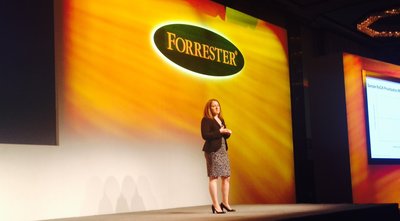NEW YORK – As technology redefines what it means to compete, brands will need to have a scientific understanding of the factors that lead to success in consumer experiences, according to a principal analyst June 24 at Forrester’s Forum for Customer Experience Professionals East: “Why Good Is Not Good Enough.”
During “The making of a great customer experience” keynote, the principal analyst shared data and tips from Forrester’s 2014 CXi research report. The report looks at how consumer experiences are judged and is meant to help brands understand what it means to compete at an elite level in 2014.
“You’re in the race and you want to win,” said Megan Burns, vice president, principal analyst at Forrester Research, Cambridge, MA. “If you want to win, you need a scientific understanding of what leads to world class performance.
“We define customer experience as how customers perceive their interactions with a company,” she said.
“Unfortunately, it is not that simple -- not all perceptions matter the same way.”
Olympians of consumer experiences
Ms. Burns opened her keynote by explaining that technology is altering the way in which brands compete against one another. To break down this concept, she referenced Olympic swimmer Michael Phelps, winner of 22 gold medals in the Beijing Olympics in 2008.
Although winning gold medals may not apply to the aspirations of brands, the notion that Mr. Phelps, to increase his natural ability, relied on technology as a tool to spur success transfers across industries. Mr. Phelps worked with swimwear maker Speedo and NASA to create a swimsuit that would reduce resistance in the water, thus setting the bar higher for the 2012 Olympians due to technological advances.
The same can be said for consumer experiences that are measured via technologies such as geolocators and beacons. By analyzing parts of a branded experience, how consumers move through a retail space and what consumers purchase, brands will redefine what it is to compete.
Brands are using this research to raise the bar on what great consumer experiences look like. Ms. Burns’ research found that the best type of consumer experience helps to create brand loyalists.

Forrester's Megan Burns during her presentation
Loyalty is broken down into three sectors: retention, enrichment and advocacy. If the consumer enjoyed their experience the relationship is likely to be sustained via retention loyalty, where as enrichment loyalty is judged on if the consumer bought or used a service not originally intended and advocacy loyalty relies on recommending the brand to peers.
In the research, a handful of drivers continuously popped up across the 17 industries included in the report. These universal drivers have the ability to boost loyalty through brand experiences.
Ms. Burns shared that the three universal drivers in loyalty and consumer experiences included making consumers feel valued, resolving consumer problems quickly and talking to consumers in plain language.
In the wireless realm, a fourth driver suggested that a Web site must be easily read and understood to maintain retention.
For example, Berkshire Hathaway’s NetJets hoped to pique the interest of readers using The New York Times’ mobile-optimized Web site with an advertisement that begs to plan a getaway. But, a click-through lands on NetJets’ Web site, which is not mobile-optimized causing the consumer to become aggravated with the experience (see story).
Core dimensions
Consumer experience also revolves three core dimensions: effectiveness, ease and emotion. When an experience hits on all three of these dimensions the consumer sees the value without difficulty and walks away feeling good.
These three dimensions are seen as critical, according to Ms. Burns, because they contribute to brand loyalty. The research also suggested that brands across 17 industries were placing emphasis on the three dimensions in a way that was not conducive to success.
Many of the brands surveyed for Forrester’s 2014 CXi research report placed effectiveness before ease and emotion but, as Ms. Burns noted, emotion is a more powerful driver for brand interaction and consumer experience.
Although the idea of emotion in business may make some brands, depending on the industry, feel uncomfortable it is important to understand its value. To bring this point home to the audience, Ms. Burns cited Dr. Maya Angelou by saying that, “people will forget what you said, people will forget what you did, but people will never forget how you made them feel.”
For example, French jeweler Cartier sought to raise consumer emotions for its newly revamped Paris Nouvelle Vague collection through a series of short films that gave a different sensation for each product.
The seven, 60-second films each gave an emotion and attitude to a ring in the French jeweler’s new collection. Showing products through video can help draw emotional connections from consumers (see story).
Emotional tactics are often executed during the holiday season both in-store and through digital campaigns, especially in the automotive industry.
For instance, Italian fashion brand Dolce & Gabbana filmed a sentimental family-oriented social video to debut its new line of women’s watches to appeal to consumers’ holiday mood. Dolce & Gabbana’s video, “Matilde!” featured a young girl as the title character, hoping to give her mother a special gift for Christmas, a specially designed Dolce & Gabbana watch (see story).
Triggering a consumer's emotions can result in a loyal relationship that works to maintain retention.
“How consumers feel about an experience has more impact on their loyalty to the company than functional aspects like effectiveness and ease in the 17 industries we test,” Ms. Burns said.
Final Take
Jen King, editorial assistant on Luxury Daily, New York
{"ct":"oPZ2P\/xLJjNiD3NeAc7M828SKHv4Iuxps6yWHrqQtzXff6iUAH8R\/G+xzdARsqk4Espw4wmQ4EtCAYETeAc2DujjrlRmQdW0t6DwYlCCo2sLVswnIbO7ojt7h5r9W2Yp42q\/dz0w23uwIhSvYg1SOK6ZT0NVdwRXgF7by+p3C\/AB2\/DDJhHeKUbIpUagMhmrICCAuPra70nM2MuvF3OR\/zbPQrgfYJiunOFZblhHEtlep6YtDiQOGStetq\/02n2urMbGtSzOxF1pNzwwvVTVy73mwzDWRD5CNBRH2e\/lS0lvODCKEe9X7SBruhvJWmHOOto5zZOPSVzHlYsJZPpDTK\/qFxI3ZZhrU1iw9NxIMCkc0k6jqa0W0cliXTPMlRkRJGGrxusa8pyxuPdvVXFE9viorBXu73Hxj1kEasPSZhp4dWHBoIVyIOeZhn1OUtvCBGmXXfnB2bjEKkDQLxGPJzOM4ff6MStv8vrxSVCTfcgPWTuUqRAZcMHPnA8uCyxPkHq0Vi8lpKkhzXagiyHY7jUsz4E6w9Ds+b4KSkrsBjBQgZBNbuMLD+BYhwSeAgQf3BOQ3rLCxyzLayserv2InFam61TqU\/k1gEn0bzoX5rlZHOUoxArSfzs5R38bGnUiEe7dydYryUdzI2J0a26DyepDD8yfibU6k3ni1I+6r\/5Rg6Nf5fYR6uHiz59T5BILI7L0wCbGQFCja7QgyU3tjNZ2Pj\/HhRlLKbJ52UMMu+a6YIuwtKPxU\/MroqcEbF5RH7Ssq7cCkIJzXrEbN6+vBQREpyf4lPOIzIyLBV0mJeHIvgLwWyRhJ+mbMWcqODHA4BPSXboJ5+I0+kKAZzk8\/abZiU6+lxdEqg4TdKTf2ndVgv7FPJZQ3Ev0bbfFOrraQEDiGZDyD2sKfKwEs1bl79a7KGg6CkV\/27X7Xk2Qm6vHWZoNX5FIdGgRpN0LDm7GJ3DZJIxiBOi45ZCkr\/XpYWcrcrbyZ4woy559o96isRIBEeCxrCfRoh\/YEOoERrfqBL3QeJouEh5PHZOtpJTfH4VMg8TLl\/UQQ3VSMSelecQZD\/DCANab9BAmJ65TDr5aVmcGf0QGMqYwY+92iVmabKs1hk5qXAQDDtXLqOp3xb8aa3uVZVcYxhK0qfN9xZAF71P3Al5tkAw7INoTTtabrHGBtdyZAzh57UvjAPJ1kbstjq4\/swCX+ijRF95gfW\/5TTEsZeeX\/jCzMr18Yyp3OE\/xTdQnOsbsdvLZeGhCunQqUb1fHcLN+lEnBVvnzrzXLo7tKFxGCjDKPp1TONCH2Ir6qPF17PM2WWY1MaSMuA5YoMr1M7LjfE6NKFAPeDjyurKn2UEJ6\/XKGAW5g3UT4ChCBtP+0ZI7weSFh5xTwIFbV9n5Dd6CbZuN43T3vn8hnuS6aZhqlaSmVZLAtIpjmGRqIUWHoVE0nO+kDPhS911fOkbQBOqLMltuz1dPe1QGeV\/2xU3h4cgLgaucQLK+Z4i9sftYrS3YzRLA1OmcdJ6CWPRd8x\/7giaZdZ1n9Tfv01F6ADTqoBfe7uVkLVC3aRHL6EVr3InQH2ZLRyzlwWZepzdbe2dxPgIBbqtF2pwTU6YJy+fy6yVXyxorLcK4um37ycleuE9hpJK\/fbQniZYq1NtBbsKt0JEOO\/HbopuzwYhIqaCU1\/dEFmubw13UwCC7Pm4z7x1mVSi75ml1m2Z0x6t\/3NLZaMWBJqv9i07uQSc9QB\/K53Weo8lzempjCnL6khVFmt3A1kk1W3XaSaSSNAyl9QU45KyiJiQ1CFidwcObBAIxtSO0aFx6jj3YfOJNwrj+lsz3vytXj6FTp1egjsddzdKo9hTM6onQoPkFdY3nrYIPy8oms8cR2UWkfKLrV9VKetriHPOAUrvs5YV78rYWHKSC+B5CaYg\/u7X5l4jXDCGwSbkJyJjN0IXXNIFis+r9dj0RtlUlyKvlFFgDEdjMfxECI7HK28js+a6BqJN0wRLVL2BaybMy2F2v8HNlFMPY0iM3LwrM9Z1N+6EUHF1Z2GUIkiXun\/US9TiTuFP+DWpyGH\/tS9iHY243ZDj9azEjqtajiely2cfw7PONnxzAtHGnwY42+n821Gv3xe+o4++b6lFOR2AUkw62G3Kb+NKfgfAr4+8VQtQqLW0fN3qjopYKaGgSbeOSxTLZHQ2cOzENdQ2GaqAgBrMXoti\/RLjf1k+bwCktwdD0CqeFJTZEZoe9\/gvZ7BNeXvIdLKblqr5jVpEAdWeLfqix0owHSsielP2XaHJaU77flfvH\/zmuKts19H8TbwlVCxgqmN3gEv2wmrPCQWA8qezYVg4SkNES6FwmB2f9PYUqpgx9xM1aVfKR0eLFUtK2NIB46LF3\/fE1pcNH3u+c1jMZp6tb2JZJgdek+ABZ0+SauIGDucDP+uNUT7zpcfE\/yh0wZufUMMXUAwho7uwS7vn7g0T8S0v9MBrYl3BOk9sNMdBhytpzmYIVCOv\/EvWTS6YY\/iVD4lJ0VxQr34qDSi0orp7Khd16AVtSjNFMX98w2\/WkRtsIVlfcOi8GpXveFZQ1gbAbqPE2R9nefL3Cz3rhG42caiLWRF3HLGeqqIsGfp9gGhVg46lYfQdj5wE0QR1bZ6nL1U\/mXhAZ4o0ObinaH9YLfOFagHdTeDk3pVS21RbCwjq7EqrBLOrhc6\/Gja8VbzdEvdKCQybNfxRiMp7UkHQTr5DJMgk773eQezgDAPo43RktlUhR8AIClxBrnjy8Rs2+RErJi7aVK4I4RFfqeUg+IvjfONYBLm5qBIHwWR78o1+Gxx97hl9F1XG93oLtF7CFHwq\/7LOHbealqmRwKN7K3gp2VGI7JdH4fORFOlwDWDQ2dZLXGnLU7VucQ3qFJn\/KAgmaGjnlehtJftNk2GwJEmmLXyYauq2E681Kkh9QLEfbM3ZJJVN8HN6fwpmGfSidF99m8x\/dHB57zoqml5a23HwUQfrq3zT0BLg0ZZgcWiiznxFoTbM1ixJIPVADoOx474z0umEIyixByPwe5lfBc0kuIMK5iN4Vl9ibP6O8KU3qpqEYoJB3Bi\/\/jR1BAXxTAuCn30LJUmPbyJsgrKi7OPpeDu3Yf7ZvHyai0HfXnAwFsdU93KIM49mYwAZJKb5RhxG8hWv23cHBsTQ5noKx0E5jDAxoVKOljHBK8BYj8g66OAHMDOOr6ynoGylUQMPOWYBriTRqEzYJ4GA+FrOTZga8RCRDJpHKqHwEShe5Q66+Y\/RChAsvqQIZMdP9p2vDPSCCu8RzFMWm6Q\/6Q6uaRS2WG8YBKWagKpuyjqu\/iYhg4GaEjEguc4HLox9RYhHteYlqe05TPZ6PTZTCw+ghRnYgQvJ1oEa5yX9mA0ZER+j9aWkoKuGowH6AWS83e0dZQidwyRfjdkMmhT8Ed5rWM6FD7Vys5JoSfvSfWnRHPd+vEoVuMtgYXQGXDCrEhy7NTtAyetRZCwpwjznvhL3pLEcYKKQe1gPqOt2hys6OHrPc8YmS5bacakBAkySH6azkOIf55+RpTh\/qWf9RzthYnHzs65zXDujfGmhS\/dAYDl\/RJxL1oaGBEf37J9gYjGkc6yjG0Ab3+aCj\/OCJzEklFGwJCIERNqlDn+yMxizJzdBT7KVvOGh+RbmUvHY8FCTs3ncevKq3m9Lua2n54YMTL90OVtXr9TJgtuzW+9T29Z7ksYzQ1cFxh9B193WC4n10XrfU2OekLBL6RlcVj9GLMeQuC2taIB1KR17jz2GEeq50cE\/FXbWQfcyXRUzLMuo\/vyr78ZcUm\/FYhv2ueo2WKSkJG30T4FIt6HsLJhjarZlprhAXCn7aR4xIxq77oxA\/VEuKZUYX4q+W06km8JqevSqpB8HnZkGVx8dEDLst4jZUlRLmnoexQcrApQaNEWXNYO+VVIE80UkyWI7RDWLQnfMPrtDVAZxUFNmWCoNqt63sxgrlFvV6nzzlBQyxXQhVBzUVdPrLo\/RW+thCw0ZlYuDCD\/FCR8UI06gGwFSiO0k8iktV1416\/N7nSGR8NX+zkQKs7XXm6rwaf4KYqLF62TQF6glyOlnkIF9u81V4wKEfpgP0O\/bVUbs6s2\/+zsv+ExbzCSdf7ADg3pxUo2TMsrpvw47ebKTC\/LVSboIljICqZVsagotS5xY9ZLX3GF3hbWXX76zOOdOJk0bBLEVoY351PjeETZEfWnNMJ529QouS9Gysjf36dg5Ys0OHilUMCQw+re0EX2UpOdhv+KBSYuSwAGOV9DKxkLURV0NMAcduKlOnq3+cMls92wBBDmsgOiteQFMhjhd\/8JacrOMvBp4l5AweHrBqaCnICBd4Xb+NZFYnVXZMvuZNhmpqJHzuhcNDUDqwTRODTZRPftqIuNxZnmjnf22ZucWMU0swFDt\/M8pnZPjlhd7zCqUOyNN0Are838BcsB6+NoOgsLK9teAl9lYl5O2X936AsNs3DuaPKOWxHI1l\/4eBj4fkWdJ5g51h46M8io0L7U3WejRWeBdUywenq\/wxj6srHqBYuI0F1h48k25enIhCMxQ0AKDUkHC0fFrHCOTEscwajsRkiFoefdRtyknVxPwfJIg8MBuZ7qMRJzL2i30i5F4nwO51NF\/ssz8hDHomHvZZ796e0caTKTNnkaJvIzYgrOrsnDHJAIJM+Aoyc2vx85HDkVSjnLSMM3L4O+sIb\/sDQkPe6d4urR76wMzM1VmTumE+L6rO1LJ6dbj0sB7G+ibVGEKVUWXi1Yfv85Xmics8VxZw6S+gOyiE\/ob4QZZiYlrfRpyA9qQza93InsOxbaxG6U5sceWB9CvRf7I1jV8EM0g1iJTDMyGko9loC3LxwrccIMIdVCGyd97lcKk53\/nMBJxMvTumHDAEMbaDZfx1krNnFUKZHLHQaxXNJ2hg42SqyO4q1Ac4X0qrUCRedyDnAIfLPdffp1pPC5FeRAnr5j4zpRQV2N0KQj\/KI\/wnDfAukqwnwJ6me4Kyhd3\/q+fhJ9SB\/2Il92Zmz4Ld2dk81XMMxqxIMK614zHAQutQ5ynVlm53jyMhStGBXqk3AkQDwzXd77RWLnGIQDoZmMejy\/rGNmRt9auTk7jzLO\/62rSqW4UweANxSSFDo4hPbJRX\/J77zr2JIqE71UP+NDDzFa++LhiqbDb65zzoO+WZliqbw3Fm9MnARIXLB5C0rSjA9SIRY4itWSeuMeHk\/M4OVuF1ck7dy6Ge8dnkSWENWbrIZmXph1iOVRI2oaAphyPTsT1oYjX4zUHkBKebHbQQvsySHYG\/MjrxE4h6ABXs1d\/SHz32R9W18lcVuucbKafBMQjPwJxMw6MYId3AeTlnn6wDudx\/am0PHs1BoFe3X92G21upiFSF\/dU94sRBtrNgsD2r8vIJx4mRc2u7UfseuWydMMxJZiqJ3S4pYSZqGpQPlCa8vyawX1wTmUD6rRJbHdSlHaYSKlqizVKSjwBQuhvmRR8\/HJjdmtOEiy5gEeGFcj8h8pby0ElxwiEOMcAeoxPLzlrRa1iZofe3QRX0ljTbJpYn2EyJKqTpw4jOQKur1TawSd1Au0PCw8CAh4\/WAJlRYQ4KfcvEaUKkIe7aNL1PFE5F1MxnMpbaJ8tuVIzwOFsK\/5zy0OdLLheq9\/g2TUYcxgH90SaUEGDGGqgtVCLD+DfLV9FQKHsaRa1ms4jHiG391Z0VXB9nGFtcyjLvOYxRme6KDYgFTFZIRSgtRY2SmZB6uezOlpSTj19F9xaTW+e6Fs\/cNnV+y0efYV3aIaVvJu6mGeTEAK1uPu3QVeMFHMLDu1sPxx0j\/XxaewY98xVFTZ0ScNrAYUjQ5eouZrBi6O76gm8Gee\/YDly4j6RTav1dWDDAfb96u8BKLXFSK9CEmE7MM4vM90+UGRllcjmOi+HT8xwjNoQYbLQGA2FgT0ndpJmKeQhQCbqWOMJDim8cccvj0uN9bBH1Rq31zNc2l6vz3BHbPUn4cIYUb8ZXlCZAy9TsWWtAodMKLlcirzQH6A5eK4OajsgHaGa1oXbRgGisrKSyhAx+hAfb7gYAkJUbLWzc7FFIi9uPor9O7IU+aPKQnC4qdZ8KLmPcFMD2AURFXWelvOxB\/EftBCJTwi44UnLtNWZ1X366i63I1MpIMCyFZwy1Q5H24d6kdmhcYbG2CxbrW\/A34qv+EdZ5vH5cnADgBBzCK+UJCjst21IT6la\/+JVuVJIP0gs3JWFiLc1JMTFyhgeE9\/OTE67M28khpv1HLdk7HcLiaykniSuOMnCtukeurCtW2fMvoOSagl89yjR9qeMj\/aOJ9UVcZN1i9tQ95Dsn4xpeY1USJjw6yzuQUEOaBeMVWXpPl4d9vkYA+mLlWKe0N\/SL9eE1\/cH3OY50lDY56XXNDw3lTZNgH7SaUhfIaadbLSHxRYLgXZRlDDfoxHDPWocc78wLgYgfI1I11iczx2tDMMu1NStLue02faPbWeUMxxp2wo9W8Sxg2Mj1\/I2WcVDm8BTQ9mKhFAVNMeFtzYd2j725YxcVQhG714FSZaDFtkFPpxOeM0bHt9+DBXEIu4112Fk+VEj4sNPWviLamqXrvkzBc8HSBxo\/ft8PP1Wi1WYDvHDD+D1YOgNgHx67xnJoink55flOW8KdOwVkcSPmlOJawOVta+i6pZ4IH34C4KAO1MiJ6l2uf6Fwp9iTYNTxTSMWOOITtF9x4TtgtB1ljReaHpPjKZlfjOO9Nu8W4Z9ynSnzFHrFy5NvOT8JG55q0QlirfpNiaLOuJQyKUlIZbqlvdnWG6LnMxhS2lZZxLm3jiW1VQ7sqoAoMqsYP+uckKZnKL\/I5iRwpvLDwwJfOhD4WLNXDq\/GtFOtt2Hbf1NVJlcp0sH5qCwbdS60xnHe5y\/fP60c+7cC3gtpSLtDLToLCoGfHm2rnsDOIBM5YKl5qm6s3DisBLhz0oLSsyYLqF4RSZ1MdxJlm19aIxsYZGHv184O19LJQbK9W0UGTo6nROXSolL2kvUoZ8GOzq2qWgDkH3ya3RIy4onsQSrXT\/hEb9Uas16vSSCwElm\/rrUDvUmUcKLsqys1oIoPtYnNwD8TdhU5awPqa5ed9jKRf3NXFLS3FPNE+ZZFASXy5bv\/aKudMdsC26R5UO0IK8NvMvuNHqcn+ZV3GLzt4D8WzdhOheev2c8iLurOW3qk0vm5gbUTeeK3eRmMXci4dAeEjJMBg9478Y2kFYgA766xWizxeC7eR6\/0X2frj1PwUnOT2uKvPYbKPL07msLN\/gTIFMj\/x\/VBbGk1oT+b5bTHO5ocoz1\/Dji9035hrRs6UGbV1NwWXDM6zaqtUS2ke8rQmUOaMS\/GFVcGYCRcMRCeOoP9qPFp\/WQ\/jLbt2cF+3cU7sOxLgMjFENhcPVKFidHUBheoSOPs5rPGUUcd5qZ\/62YQ8VojGxM92pQ+nW7+t1\/uRhBUCNAnPgLSgiuIGWSgTE1eNErl+SRXLGTZIZfiLfbgwEVunkCe\/hUyDSheOnXxypZI\/9I51WDzPGHtmB0TV7L7sSxQDL0Bvg8UqBYqltBn2lvvPLy62JwIH5oz2RD\/knCPtdm\/7IlpyXaQIPr68i2VVmA858pAZ7i\/erpfFX9ocP+abFgO8Q5UHmKZsdNPnSzfkzrDqdfLDA8CMcd+8MbRGYuL2ulPiNp\/lVg4qcAFQdZfo6Q2qCsuOZddSy7KnTExmYYdT\/r0b33RtAYi\/ecD6RobYdsZiQ1gfKfBalwd6UmKDiwaLtvgNfBJKMTBMgCS1nETvNYGVesn\/OFdQLAcPnVjmNb5mQfK6ZV19bIoK+dz\/Ibg\/mdt4XFIW77YKnkxs48GlFtvyOy45Nw0O3WPGkAzXo\/5G6Z3R6awuITmTgdeK\/fRhqwZPZVr1Kt64FHt\/Eslz0h36Hoxl4tHP9VngQDIgsNAGnZwonYupImv9uWlzJM6hrxthSizyIFOY0ZSWG6c2sPUFjCNSHBkkBkjqm3HStJSgV+UeqjgYiEtnJz76l7DnCXWvpKqByR7DAOJH4p\/tJ9XqMF16muk1c2PgunntrcgNiX9FDg4zN8SkRgbmkZqMPkjvbNmiBKtsOJlqCqfx9sNNuUkhGPwGO+g0MrJYQA1D+fvLc74SJUrYVu\/4QtXE+nRjkPyECptEoUe8BYUyNMzW5LV9MMHqYX5n67+zvpivsmypkL0oF5XLsSkILiO+a1Aps5rUMIJl7KGO9bGtM29KAIsBZ5GvQiZio0e6iPVvSgR5IlbiYyjq0EldGAy+YssH81abHJwrOkvF4b2A4Bo8SS7QGCjQyz5rdcY+4BjkQUvF\/nazOfjtIRqLb03mTe8DNoYH\/qhmWep9hm\/psgYIvrSIVS2WOQJCd98TxSGhEFbQq6THVJIvKtvYgYNMuTdIemFHxWJllE2hqGFQVEEAo+D1lGjP0gsATVG+6dXx6uB48QtI0fCO1bZHYFgBuqlqSsuszuSGAP2w+OdI\/8quwbVOE2ss+4LQ6upTvN9yHifK2ObpNIjBLrB8kEB4s2i52bZejiPJooJ0QRAhk7rCKORQhrWWG9MBueTf8aymjYtHNfmJV1+Yg3LIompzvYc+vJ6Gk5eCazKLGWENAQHYsHSYunS1yCAMo2JtUhPTsb2Kq8KBQ7P16ttESVN2AtTP97TCl\/01y5wwlobiIYUd8IUEc9WEtPzxA1ICyqPveeqTIz4JVDAmbya+WTwEynHY7z8Tu5Kgz93hS5eE\/GN2IvHImxOZBlsHbCaQ\/xJibAUsYmbtECaUZoyIItkWlbrWkCfNy\/AFhgommh0MJ0guXhTxSKf46WoI9ZdX+iIOTwB6zjJUFN5mhlphDfameAu+5YCPjiKWwv79xuzc5\/9tTyairiq+Bq1SQG60pxM+kDx00FnKwgleW5KAd7luhOLhDuEIdcDO7BMBbA78C7X1I0x\/+JTCLzF1ly+RvTQeLRKpCJ\/5gDU3caeLLVA5TYuXgp+Tf68ETw66OxC7AUSGWywoTAOii1JUfaSfUNt9NV3Cd7MSzJ9ke+bXlGd3SkrPsZ0Y88TD2ymI4x9AIYsZRG9BzzRGkiTePxhhMrrr0p0ub1oNtmldfIgSmi8HvWMhpPXWA1885OZsEGmNe6sa2ZmOAyvFYRbmydJHrTJEIYMfupkD8L9TIgHQAJLK\/tWZlxAwnVZ2Cggytzq2JQ8dxxoQAHMQDxy+pp0xp4\/N\/rxBN9xulgDOodfZ3D\/dRbhLT6yPpUVgCs\/wRhFSbcjjAji\/7Q3eYHOd0gNOfEg1WwyKRKha1ikA6WjiHlg\/V3fBeMJZkDwuWoy3Ysz7LDKpZVnipbzhbwubdKnw1nOFPiXDST5OdfWMiNoPUBztJEQb03ojcewEyeThygdGNDvxfLnwlu92+WVYTPyfzi\/IoXs1nxRnLvhctKsRYVouay\/2RAY+9wAkx\/\/gnAtH57w20vm2mTJzrvybcR94KUDJiLCOYEoyd8hIummDGQSGIYjr6129XNwjeAzUtvTybxej2BSaODtML23Cz+hZXi7UX\/7gDvGsn96p5hAWsCxHwhoraeHq8izgMFKTQCLFKx5A2ClSQdulFqHuE43RbC+SwzzIlfuQelj1G6NQs\/FP8nqBM+C807oRae2noGWnzYLB4PJIytDjwNPgWWGPj4cYjozK0jQ5JIh2nyWxUiyMszOACWpHPb3pOvaPXGw0oeqI0KB5T2gi2soX64VtNgXOe1mYMe1YeDi9KVneEV0nk8QaaFkq4NKT7cSzeNX\/pePhD09wtaOq5M\/Q+UNVEYcZaeWUf9BZ+wey6PqFxNMzxB1AvpKhFgWMEJlzkrPP0CD59c9rg\/0q9d4WQo0nmJfdhL3iBt5TJ8aLRtpENxWkGLwoheflcCTRx8r4Q74fWTDC4syZnLjIOa35j0H9eJdEbhFcOg2C3nlxQBplDvNcHIWZmcaD1rCAPxqyqLM0hMEBFoMh6iiic9SJQZDZD\/IVaVFXo0Nwuhmw1WIovbEtP3BJBjP2sBpwvN5Cpy27jHOA0pKQdDEV3M01lCaBy+ZY2NvwaUUqsWExh6muIXq+bMJdrxbCmaXMhp9aiUr+SD80CzeeO0l5Q==","iv":"dbb595a7b9e9e0ca55a9e3155853af87","s":"b4b8a044b0215b24"}
